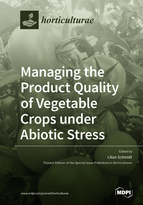Managing the Product Quality of Vegetable Crops under Abiotic Stress
A special issue of Horticulturae (ISSN 2311-7524). This special issue belongs to the section "Vegetable Production Systems".
Deadline for manuscript submissions: closed (30 June 2021) | Viewed by 43966
Special Issue Editor
2. Department of Soil Science and Plant Nutrition, Geisenheim University, Von-Lade-Strasse 1, 65366 Geisenheim, Germany
Interests: vegetable quality; abiotic stress; photosynthesis; herbivory; climate change; carotenoids; anthocyanins
Special Issue Information
Dear Colleagues,
Vegetables are an important part of the human diet due to their nutrient density and, at the same time, low calorie content. Producers of vegetable crops mainly aim at achieving high yields with good external quality. However, there is an increasing demand of consumers for vegetables that provide good sensory properties and are rich in secondary compounds (like polyphenols or carotenoids) that can be valuable for human health.
Sub- or supraoptimal abiotic conditions, such as high temperatures, drought stress, excess light, or nutrient deficiency, may alter the composition of vegetable crops and especially impact the concentrations of secondary compounds. At the same time, abiotic stress results in yield losses which is negative for the producers. Thus, they need to adapt their horticultural practices such as through the choice of variety, irrigation regime, light management, fruit thinning, or fertilizer application to improve the yield and quality of the vegetable product. In the future, altered climate conditions such as elevated atmospheric CO2 concentrations, increased exposure to ozone, rising temperatures, or altered precipitation patterns may become additional challenges for producers of vegetable crops, especially those that cultivate in the open field. This raises the need for optimized horticultural practices in order to minimize abiotic stresses, e.g., by adapting the application of fertilizer according to the plant´s needs. Many studies have examined the effects of abiotic stress on the yield of crops, but only a few have investigated their impacts on the nutritional quality of their products.
This Special Issue of Horticulturae aims at compiling research that deals with the optimization of vegetable product quality under abiotic stress. We therefore encourage submission of research articles, reviews, short notes, and opinion articles that focus on yield and nutritional quality (sensory aspects, composition) of vegetable products under sub- or supraoptimal abiotic conditions.
Dr. Lilian Schmidt
Guest Editor
Manuscript Submission Information
Manuscripts should be submitted online at www.mdpi.com by registering and logging in to this website. Once you are registered, click here to go to the submission form. Manuscripts can be submitted until the deadline. All submissions that pass pre-check are peer-reviewed. Accepted papers will be published continuously in the journal (as soon as accepted) and will be listed together on the special issue website. Research articles, review articles as well as short communications are invited. For planned papers, a title and short abstract (about 100 words) can be sent to the Editorial Office for announcement on this website.
Submitted manuscripts should not have been published previously, nor be under consideration for publication elsewhere (except conference proceedings papers). All manuscripts are thoroughly refereed through a single-blind peer-review process. A guide for authors and other relevant information for submission of manuscripts is available on the Instructions for Authors page. Horticulturae is an international peer-reviewed open access monthly journal published by MDPI.
Please visit the Instructions for Authors page before submitting a manuscript. The Article Processing Charge (APC) for publication in this open access journal is 2200 CHF (Swiss Francs). Submitted papers should be well formatted and use good English. Authors may use MDPI's English editing service prior to publication or during author revisions.
Keywords
- abiotic stress
- nutritional quality
- vegetable crops
- secondary compounds
- horticultural practices






